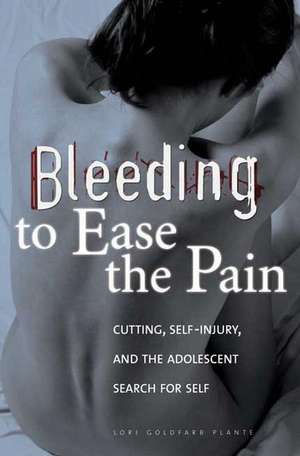Bleeding to Ease the Pain: Cutting, Self-Injury, and the Adolescent Search for Self: Abnormal Psychology
Autor Lori G. Planteen Limba Engleză Hardback – 29 mar 2007 – vârsta până la 17 ani
Preț: 320.99 lei
Preț vechi: 391.74 lei
-18% Nou
Puncte Express: 481
Preț estimativ în valută:
61.45€ • 63.20$ • 50.98£
61.45€ • 63.20$ • 50.98£
Carte tipărită la comandă
Livrare economică 19 februarie-05 martie
Preluare comenzi: 021 569.72.76
Specificații
ISBN-13: 9780275990626
ISBN-10: 0275990621
Pagini: 200
Dimensiuni: 156 x 235 x 23 mm
Greutate: 0.47 kg
Editura: Bloomsbury Publishing
Colecția Praeger
Seria Abnormal Psychology
Locul publicării:New York, United States
ISBN-10: 0275990621
Pagini: 200
Dimensiuni: 156 x 235 x 23 mm
Greutate: 0.47 kg
Editura: Bloomsbury Publishing
Colecția Praeger
Seria Abnormal Psychology
Locul publicării:New York, United States
Notă biografică
Lori G. Plante is Adjunct Clinical Assistant Professor in the Department of Psychiatry and Behavioral Sciences at Stanford University Medical School. She is a clinical psychologist in private practicein Menlo Park, California, specializing in the assessment and treatment of adolescents and young adults. She is the author of numerous articles on eating disorders, sexuality, and sexual abuse in adolescents and young adults.
Recenzii
Plante does a comprehensive job of explaining the many variables and factors to consider when assessing and intervening with adolescents who self-injure. She frames self-injurious behavior within the complex developmental conflict of adolescence, a time when the need for independence and connection are most salient. Plante provides case studies and practical suggestions that are useful for parents and mental health providers on how to intervene and provide support..Recommended. Upper-level undergraduates, first-year graduate students, practitioners, and parents of adolescents.
It is rare to encounter a work on an important topic that would be of interest to clinicians, patients and their families, and to the general public. Books aimed at the later often tend to sensationalize their subject matter, and books aimed at patients and their families tend to be dumbed down to an almost embarrassing extent, rendering them useless to the clinician. But Plante achieves this seemingly impossible balance in ^IBleeding to Ease the Pain^R and has produced a work that I would recommend strongly to colleagues, patients, and anyone concerned about the lives of today's adolescents..A concise, excellent introduction to adolescent cutting from a clinician's perspective. Valuable for clinicians, patients, parents, and the interested general reader.
The book contains information that may be extremely valuable to parents. The author addresses directly the issue that parents may feel responsibility or guilt for their child's DSH. This is accomplished through the provision of sccinct quotations from both teenages and parents. This helps parents realize they are not alone in these circumstances, normalizes their reactions, and provides hope for the future..Plante's Bleeding to Ease the Pain provides clinicians and nonclinicians important information to begin advancement in this area..[a] novel approach to understanding and treating adolescents by adopting a developmental approach that emphasizes their relationship with their parents.
There is a growing epidemic of young people resorting to cutting themselves in order to cope with the pain and turmoil of life changes, says Plante. She explores the reasons behind such painful and damaging acts in adolescents, and offers both a philosophy and a methodology for effective intervention. Her topics include teenagers most at risk, developmental challenges, professional treatment, neurochemistry, how parents can help, responsibilities of the adolescent in treatment, and de-pathologizing the problem.
It is rare to encounter a work on an important topic that would be of interest to clinicians, patients and their families, and to the general public. Books aimed at the later often tend to sensationalize their subject matter, and books aimed at patients and their families tend to be dumbed down to an almost embarrassing extent, rendering them useless to the clinician. But Plante achieves this seemingly impossible balance in ^IBleeding to Ease the Pain^R and has produced a work that I would recommend strongly to colleagues, patients, and anyone concerned about the lives of today's adolescents..A concise, excellent introduction to adolescent cutting from a clinician's perspective. Valuable for clinicians, patients, parents, and the interested general reader.
The book contains information that may be extremely valuable to parents. The author addresses directly the issue that parents may feel responsibility or guilt for their child's DSH. This is accomplished through the provision of sccinct quotations from both teenages and parents. This helps parents realize they are not alone in these circumstances, normalizes their reactions, and provides hope for the future..Plante's Bleeding to Ease the Pain provides clinicians and nonclinicians important information to begin advancement in this area..[a] novel approach to understanding and treating adolescents by adopting a developmental approach that emphasizes their relationship with their parents.
There is a growing epidemic of young people resorting to cutting themselves in order to cope with the pain and turmoil of life changes, says Plante. She explores the reasons behind such painful and damaging acts in adolescents, and offers both a philosophy and a methodology for effective intervention. Her topics include teenagers most at risk, developmental challenges, professional treatment, neurochemistry, how parents can help, responsibilities of the adolescent in treatment, and de-pathologizing the problem.


![Abnormal Psychology across the Ages: [3 volumes]](https://i1.books-express.ro/bs/9780313398360/abnormal-psychology-across-the-ages.jpg)
